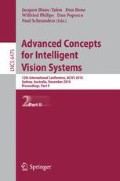Abstract
In this paper a fast and robust visual tracking approach based on GPU acceleration is proposed. It is an effective combination of two GPU-accelerated algorithms. One is a GPU accelerated visual tracking algorithm based on the Efficient Second-order Minimization (GPU-ESM) algorithm. The other is a GPU based Scale Invariant Feature Transform (SIFT) algorithm, which is used in those extreme cases for GPU-ESM tracking algorithm, i.e. large image differences, occlusions etc. System performances have been greatly improved by our combination approach. We have extended the tracking region from a planar region to a 3D region. Translation details of both GPU algorithms and their combination strategy are described. System performances are evaluated with experimental data. Optimization techniques are presented as a reference for GPU application developers.
Access this chapter
Tax calculation will be finalised at checkout
Purchases are for personal use only
Preview
Unable to display preview. Download preview PDF.
References
Szeliski, R.: Handbook of Mathematical Models in Computer Vision, pp. 273–292. Springer, Heidelberg (2006)
Baker, S., Matthews, I.: Lucas-Kanade 20 Years On: A Unifying Framework. International Journal of Computer Vision 56(3), 221–255 (2004)
Hartley, R., Zisserman, A.: Multiple View Geometry in Computer Vision, pp. 11–23. Cambridge University Press, Cambridge (2000)
Lucas, B.D., Kanade, T.: An Iterative Image Registration Technique with an Application to Stereo Vision. In: Proceedings of the International Joint Conference on Artificial Intelligence, pp. 674–679 (1981)
Tomasi, C., Kanade, T.: Detection and Tracking of Point Features., Carnegie Mellon University Technical Report CMU-CS-91-132 (April 1991)
Benhimane, S., Malis, E.: Real-time image-based tracking of planes using efficient second-order minimization. In: IEEE/RSJ International Conference on Intelligent Robots Systems, Sendai, Japan (2004)
Malis, E.: Improving vision-based control using efficient second-order minimization techniques. In: IEEE International Conference on Robotics and Automation, New Orleans, USA (April 2004)
Lowe, D.G.: Distinctive image features from scale-invariant keypoints. International Journal of Computer Vision 60(2), 91–110 (2004)
Zang, C., Hashimoto, K.: GPU acceleration in a Visual Servo System. In: ICAM 2010, Osaka, Japan (October 2010)
Malis, E.: An efficient unified approach to direct visual tracking of rigid and deformable surfaces. In: IEEE/RSJ International Conference on Intelligent Robots and Systems, San Diego, USA (October 2007)
Lowe, David, G.: Object recognition from local scale-invariant features. In: Proceedings of the International Conference on Computer Vision, vol. 2, pp. 1150–1157 (1999)
Morel, J.M., Yu, G.: ASIFT: A New Framework for Fully Affine Invariant Image Comparison. SIAM Journal on Imaging Sciences 2(2), 438–469 (2009)
Ke, Y., Sukthankar, R.: PCA-SIFT: A more distinctive representation for local image descriptors. In: Proceeding of the IEEE Conference on Computer Vision and Pattern Recognition, pp. 506–513 (2004)
Bay, H., Tuytelaars, Y., Van, G.L.: Speeded-Up Robust Features (SURF). Computer Vision and Image Understanding 110, 346–359 (2008)
Fung, J., Mann, S.: OpenVIDIA: parallel GPU computer vision. ACM MULTIMEDIA, 849–852 (2005)
Fung, J., Mann, S.: Computer Vision Signal Processing on Graphics Processing Units. In: Proceedings of the IEEE International Conference on Acoustics, Speech, and Signal Processing, pp. V-93–V-96 (2004)
Sinha, S., Frahm, J.-M., Pollefeys, M., Genc, Y.: Feature tracking and matching in video using programmable graphics hardware. Machine Vision and Applications (March 2007)
Heymann, S., Muller, K., Smolic, A., Froehlich, B., Wiegand, T.: SIFT implementation and optimization for general-purpose GPU. In: WSCG 2007, pp. 317–322 (2007)
Author information
Authors and Affiliations
Editor information
Editors and Affiliations
Rights and permissions
Copyright information
© 2010 Springer-Verlag Berlin Heidelberg
About this paper
Cite this paper
Zang, C., Hashimoto, K. (2010). A New Approach of GPU Accelerated Visual Tracking. In: Blanc-Talon, J., Bone, D., Philips, W., Popescu, D., Scheunders, P. (eds) Advanced Concepts for Intelligent Vision Systems. ACIVS 2010. Lecture Notes in Computer Science, vol 6475. Springer, Berlin, Heidelberg. https://doi.org/10.1007/978-3-642-17691-3_33
Download citation
DOI: https://doi.org/10.1007/978-3-642-17691-3_33
Publisher Name: Springer, Berlin, Heidelberg
Print ISBN: 978-3-642-17690-6
Online ISBN: 978-3-642-17691-3
eBook Packages: Computer ScienceComputer Science (R0)

